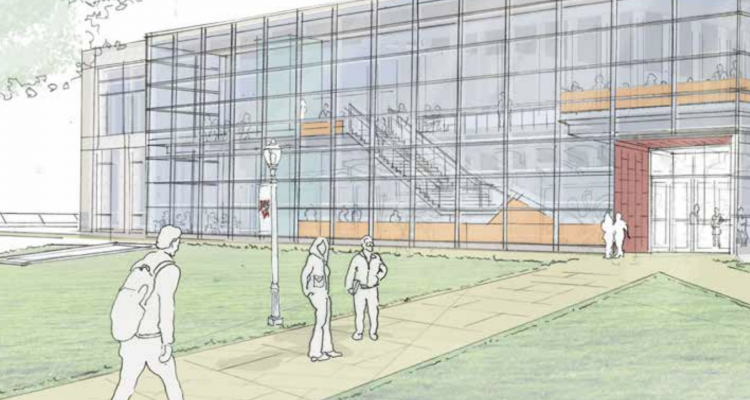Returning students may have noticed that Fairfield University’s campus has changed significantly, even since last year. The new Charles F. Dolan School of Business is now completed and in use, as well as the Barnyard Manor Townhouses. In addition, both Canisius Hall and Jogues Hall have been renovated.
Back in June, The Mirror reported that the incoming first-years, the class of 2023, is the largest and most competitive class at Fairfield University to date. The construction around campus, though impressive and sometimes curious to students new and old, is happening in accordance with Fairfield’s Strategic Plan, “Fairfield 2020: The Way Forward,” which was enacted in 2014 and can be found on the school’s website. “As we approach our 75th year, Fairfield University finds itself once again at a critical turning point in history,” wrote University President Emeritus Jeffrey P. Von Arx, S.J. in the introduction to the plan. “Eleven task forces examined every aspect of our University’s programs and operations,” continued Von Arx, “and asked probing and at times provocative questions about how we could better serve our students, enhance our financial support for student scholarships and faculty research, increase our revenue, cut our costs, and expand our reach to meet the growing number of men and women who need further education, but require us to adopt more flexible, affordable and tech-savvy approaches in order to reach them.”
Even though these efforts have been in the works since 2014, with the building of new facilities such as the Leslie C. Quick Jr., Recreation Complex and the Daniel and Grace Tully Dining Commons earlier in the process. According to the Strategic Plan, the construction of new classroom, residential and dining facilities was necessary due to “Increasing undergraduate enrollment to approximately 4,000, while simultaneously increasing graduate and continuing studies enrollment.”
“It’s definitely a simultaneous planning,” said Jennifer Anderson, vice president for marketing and communications. “We knew that many of the facilities needed to be enhanced to meet the academic needs, demands [and] curriculum requirements. But we also knew some facilities needed to be enhanced to meet the needs of the student body both in growth and facilities of what we offer.”
Part of this plan also accounted for sustainability of operations, which was explored in a Mirror article from September about how dining services disposes of food waste. These specific efforts, among other facility-specific outlines, can be found in the Master Plan, which accompanies the Strategic Plan and can also be found online. An issue of Fairfield University Magazine in Fall 2016 introduced it as, “A multi-phased Master Plan presented to and approved by the Board of Trustees in 2016… tied together the physical needs of the campus with the University’s fundraising and bonding capabilities so that the resulting plan preserved critical financial flexibility while delivering exciting new state-of-the-art living, learning and dining spaces to students.”
As far as funding goes, fundraising has been in the process for specific new buildings and renovations on campus since the enactment of the Strategic Plan, so projects like the Convocation Center, which is estimated to require $45 million in total costs, can be possible.
“[The Strategic Plan] was done through a series of community groups that were created on campus,” continued Anderson. “So, this was very much a plan that came out as a result of faculty, staff, and students being part of the planning process. There were a number of teams that were established that focused on a variety of different areas outlined within the Strategic Plan and those teams were representative of a cross-selection of individuals throughout the campus.”
“I’m in the business school, so once I saw that they wanted to rebuild the business program, I knew that it was important and that it was going to be better than it was before,” said Colleen McCluskey ‘22. “I think it was something that was a plus for me…the new business school attracted me to the school.”
The reception from students for the Strategic Plan and all the changes it has brought about so far has been positive. “I do feel that there was significant support for the Strategic Plan because it was a collaborative effort,” said Anderson.
Former university president Von Arx hoped that the Strategic Plan would allow the university to reach its full potential, as he stated in the closing of his introduction to the plan. “Above all, this is a plan that offers us the opportunity to more fully explore our Jesuit mission by transforming ourselves from within — boldly recreating our institution to serve the world as it is. Thereby becoming the University community that we are called to become.”


Leave a Reply